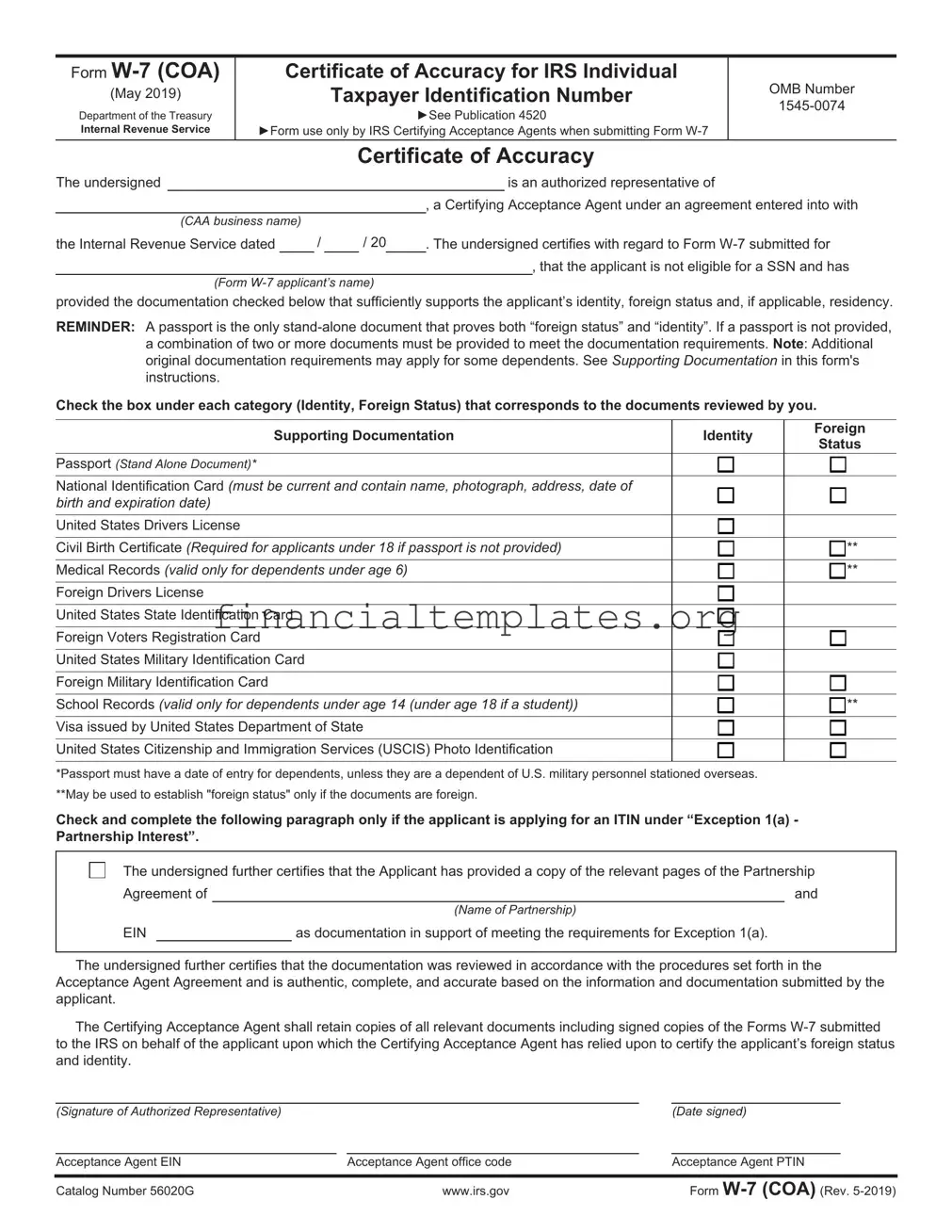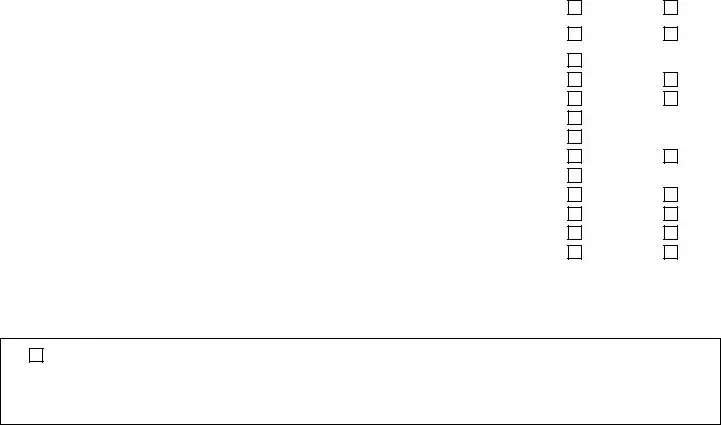Form W-7 (COA) |
|
Certificate of Accuracy for IRS Individual |
OMB Number |
(May 2019) |
|
|
|
Taxpayer Identification Number |
|
|
|
1545-0074 |
Department of the Treasury |
|
|
|
|
|
|
ŹSee Publication 4520 |
|
|
|
|
|
|
|
Internal Revenue Service |
ŹForm use only by IRS Certifying Acceptance Agents when submitting Form W-7 |
|
|
|
|
|
|
Certificate of Accuracy |
|
The undersigned |
|
|
|
|
|
|
|
|
|
is an authorized representative of |
|
|
|
|
|
|
|
|
|
, a Certifying Acceptance Agent under an agreement entered into with |
|
(CAA business name) |
|
|
|
|
|
|
|
|
the Internal Revenue Service dated |
/ |
/ 20 |
. The undersigned certifies with regard to Form W-7 submitted for |
|
|
|
|
|
|
|
|
|
|
, that the applicant is not eligible for a SSN and has |
|
(Form W-7 applicant’s name) |
|
|
|
|
|
provided the documentation checked below that sufficiently supports the applicant’s identity, foreign status and, if applicable, residency.
REMINDER: A passport is the only stand-alone document that proves both “foreign status” and “identity”. If a passport is not provided, a combination of two or more documents must be provided to meet the documentation requirements. Note: Additional original documentation requirements may apply for some dependents. See Supporting Documentation in this form's instructions.
Check the box under each category (Identity, Foreign Status) that corresponds to the documents reviewed by you.
|
Supporting Documentation |
Identity |
Foreign |
|
Status |
|
|
|
|
Passport (Stand Alone Document)* |
|
|
|
National Identification Card (must be current and contain name, photograph, address, date of |
|
|
|
birth and expiration date) |
|
|
|
United States Drivers License |
|
|
|
|
|
|
|
Civil Birth Certificate (Required for applicants under 18 if passport is not provided) |
|
** |
|
Medical Records (valid only for dependents under age 6) |
|
** |
|
|
|
|
|
Foreign Drivers License |
|
|
|
|
|
|
|
United States State Identification Card |
|
|
|
|
|
|
|
Foreign Voters Registration Card |
|
|
|
|
|
|
|
United States Military Identification Card |
|
|
|
Foreign Military Identification Card |
|
|
|
|
|
|
|
School Records (valid only for dependents under age 14 (under age 18 if a student)) |
|
** |
|
|
|
|
|
Visa issued by United States Department of State |
|
|
|
|
|
|
|
United States Citizenship and Immigration Services (USCIS) Photo Identification |
|
|
|
|
|
|
*Passport must have a date of entry for dependents, unless they are a dependent of U.S. military personnel stationed overseas.
**May be used to establish "foreign status" only if the documents are foreign.
Check and complete the following paragraph only if the applicant is applying for an ITIN under “Exception 1(a) - Partnership Interest”.
The undersigned further certifies that the Applicant has provided a copy of the relevant pages of the Partnership
Agreement of |
|
and |
|
|
|
(Name of Partnership) |
|
EIN |
|
as documentation in support of meeting the requirements for Exception 1(a). |
The undersigned further certifies that the documentation was reviewed in accordance with the procedures set forth in the Acceptance Agent Agreement and is authentic, complete, and accurate based on the information and documentation submitted by the applicant.
The Certifying Acceptance Agent shall retain copies of all relevant documents including signed copies of the Forms W-7 submitted to the IRS on behalf of the applicant upon which the Certifying Acceptance Agent has relied upon to certify the applicant’s foreign status and identity.
(Signature of Authorized Representative) |
|
|
(Date signed) |
|
|
|
|
|
|
Acceptance Agent EIN |
|
Acceptance Agent office code |
|
Acceptance Agent PTIN |
|
|
|
|
Catalog Number 56020G |
www.irs.gov |
Form W-7 (COA) (Rev. 5-2019) |
Instructions for Form W-7 (COA), Certificate of Accuracy for IRS Individual Taxpayer Identification Number
What is Form W-7 (COA)?
Form W-7 (COA) is a “Certificate of Accuracy” prepared by an ITIN Certifying Acceptance Agent (CAA) and attached to each Form W-7 (Application for IRS Individual Taxpayer Identification Number) that is submitted to IRS. It contains the following information.
•The name of the designated authorized representative of the CAA who is completing the Certificate of Accuracy (COA).
•The legal name of the business.
•The Employers Identification Number (EIN) and office code of the CAA.
•The date that the Acceptance Agent Agreement was approved.
•The name of the ITIN Applicant.
•The type(s) of supporting documentation reviewed by the CAA to prove the ITIN applicant’s “identity” and “foreign status”.
•A statement by the CAA that they have verified to the best of their knowledge, the authenticity, accuracy and completeness of the documentation they reviewed.
•The signature of the individual who has prepared the COA and the date that it was signed.
What is the purpose of Form W-7 (COA)?
The COA is a certification by the CAA that they have reviewed the supporting documentation to prove the ITIN applicant’s “identity” and “foreign status” and to the best of their knowledge the documents are complete, authentic, and accurate. Note: With the exception of documentation to prove Exception 1(a) criteria, the only documents that should be included in the COA are those that were reviewed by you to prove the applicant’s claim of identity and foreign status. All other supplemental documentation supporting “Exception” criteria, (i.e. a copy of a withholding document, a letter from a financial institution, etc,) as well as a denial letter from the Social Security Administration (if applicable) must be attached to Form W-7 and submitted to IRS.
Who must submit a COA?
All CAAs are required to complete and submit a separate COA for each Form W-7 that is sent to IRS. It is important to remember that as a CAA, documentation to support identity and foreign status must be reviewed by you and should be included with your COA. You must attach a copy of the original documents or certified copy by the issuing agency for primary and secondary applicants. For dependents, you must attach a copy of the passport or birth certificate. For all other dependent documents, you must attach the original document or certified copy by the issuing agency. IRS employees at designated Taxpayer Assistance Centers (TAC) will not review W-7 applications prepared by CAAs.
Who can sign the Certificate of Accuracy?
Only the designated authorized representative of the business is permitted to sign the COA.
Where can I find Form W-7 (COA)?
Form W-7 (COA) can be found on the IRS web site at www.irs.gov by searching for “Form W-7 (COA)”.
Whose PTIN is required?
Only tax practitioners are required to have a PTIN. The approved authorized representative of the business must provide their PTIN on Form W-7 (COA).
Supporting Documentation
You should check only the boxes that correspond to the documents which you reviewed and certified to support the ITIN applicant’s identity and foreign status. A passport is the only stand alone document for purposes of satisfying both the “identity” and “foreign status” criteria. A passport that doesn't have a date of entry won't be accepted as a stand-alone identification document for dependents, unless they are a dependent of U.S. military personnel stationed overseas. In these cases, additional original documents must be submitted with the passport to prove U.S. residency. See Part 4 of Publication 4520 for documents accepted as proof of U.S. residency for dependents. If you review the applicant’s passport, you would place an “x” in the box under the “Identity” and “Foreign Status” column on the Passport line. If, however, a passport is not reviewed by you, then a combination of at least two or more documents must be examined from the list of Supporting Documents; one which satisfies identity, and one which satisfies foreign status. If a document does not display a box under the Identity or Foreign Status column, it signifies that the document can not be used to support that category. For example: A Foreign Drivers License, U.S. State Identification Card, and U.S. Military Identification Card can not be used to prove an applicant’s “foreign status”. Therefore there is no check-box for those documents under the foreign status column. They can, however, be used to prove the applicant’s “identity”, so there are check-boxes under the identity column. Medical records valid for children under 6 years of age and school records are valid only for dependents under age 14, (under age 18 if a student).
Definitions — The following chart represents definitions for phrases used in Form W-7 (COA).
Phrase |
Definition |
|
|
The Undersigned |
This is the name of the individual who is preparing and signing the Certificate of Accuracy. This person must be the |
|
the individual who has been designated as the authorized representative of the business. |
|
|
CAA Business Name |
This is the legal name of the business that was entered by you on Form 13551, Application to Participate in the |
|
ITIN Acceptance Agent Program. |
|
|
Agreement approved date |
This is the date that IRS approved your agreement. You can locate this date on your CAA Agreement. |
___ / ___ / 20__ |
|
|
|
Form W-7 Applicant’s Name |
This is the name of the individual for whom you are completing the Form W-7 and Certificate of Accuracy. |
|
|
Name of Partnership |
The name of the partnership should be entered on this line only if you are requesting an ITIN under Exception 1 |
|
(a) – Partners in a U.S. or foreign partnership that invests in the U.S. |
|
|
EIN, Office Code and PTIN |
This is the Employer’s Identification Number (EIN) that was assigned to the business by IRS. The office code is a |
|
number assigned by the ITIN Policy Section when the application for AA status is approved. Preparer Tax |
|
Identification Number (PTIN) is required for anyone who prepares or assists in preparing federal tax returns for |
|
compensation. This number should be entered on the line for Acceptance Agent PTIN |
|
|
Date signed |
This is the date that the Certificate of Accuracy is signed by the authorized representative of the Business. |
|
|
For additional information regarding documentation, please refer to Publication 4520 Acceptance Agents Guide for Individual Taxpayer Identification Number (ITIN)
Catalog Number 56020G |
www.irs.gov |
Form W-7 (COA) (Rev. 5-2019) |


